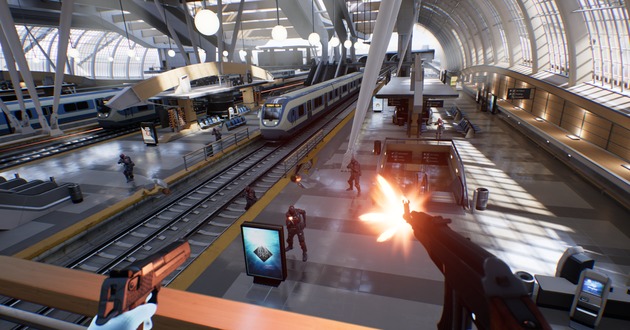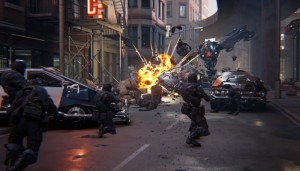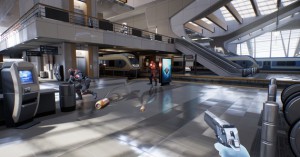Epic Games’ Bullet Train was arguably the star of the show at Oculus Connect 2, Hollywood, last month, showcased to attendees on the consumer version of the Oculus Rift head-mounted display (HMD) and making use of the Oculus Touch motion-controllers. Getting down to the nitty-gritty of the technical specifications is important when discussing virtual reality (VR), so VRFocus took time to speak with Epic Games’ Nick Donaldson, Environment Artist & Level Designer, about the project.
“It’s running at a solid 90 [frames per second], which is the refresh rate of the device,” states Donaldson, confirming that the experience was designed on a GeForce GTX 970 graphics card, though at Oculus Connect 2 Bullet Train was demonstrated on 980s, ‘just in case’. “We did all our performance profiling on a 970, which is the Oculus min. spec for when they release.”
Bullet Train is the latest in a long line of VR technical demonstrations from Epic Games, and follows last year’s highly acclaimed Showdown. Built with similar thematic, Bullet Train differs from Showdown in one very important aspect: interactivity.
“Showdown was a very highly scripted sequence. There was a fair amount of work that went into making sure that everywhere you look something was happening, but when you actually have input, controls, and you actually have enemies running around you, shooting at you, the amount of work exponentially skyrockets,” stated Donaldson. “We found that out as quite a rude awakening!
“It was kind of a challenge to get this running faster than Showdown on lesser hardware, so Nick Whiting and the engineers in Seattle actually did a lot of work to make sure that Unreal Engine is now running faster than it ever has for VR.”
Further explaining just how Epic Games managed to achieve the visual fidelity present in Bullet Train while not stumbling over framerate, Donaldson details a new technique known as ‘instant stereo rendering’: “Instead of having all of your meshes that you’re rendering and submitting them to the GPU twice – once for the left eye and once for the right – this time it just submits them all at once and just draws a copy on the right-hand side with slightly different transforms from the perspective of an eye that’s 6 1/2cm, or whatever it is, across. That makes a lot of the rendering stuff a lot faster.”
Concluding the technical details, Donaldson confirms that the resolution of Bullet Train is inline with that of the consumer version of the Oculus Rift HMD.
“We’re running at much higher than 1080p, because of the resolution of these displays, and then we’re running at 90hz instead of 60 or 30. We’re pushing so many more pixels per second than any kind of regular gaming system.”
Bullet Train received its debut at Oculus Connect 2 last month, but has already been announced as part of the line-up for SEA-VR, Seattle, later this month. VRFocus will keep you updated with all the latest details on Bullet Train, including an in-depth interview with the development team coming next week.
-END-
The post Epic Games: Bullet Train Runs ‘at a solid 90 FPS, much higher than 1080p’ appeared first on VRFocus.

















